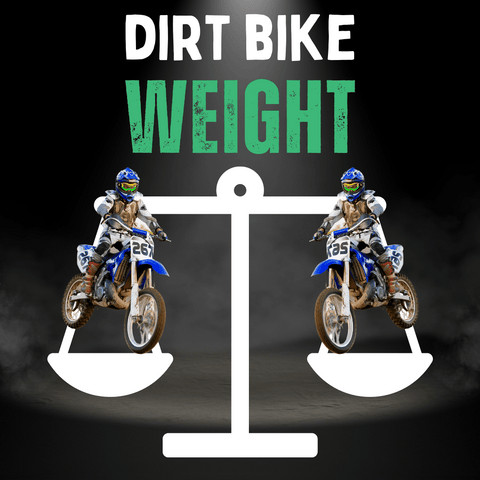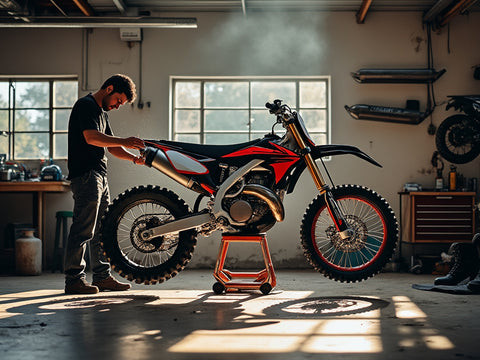Are you curious about how heavy a dirt bike is? At usabikers.net, we understand that dirt bike weight is a critical factor affecting handling, performance, and rider experience. This comprehensive guide provides insights into the average weights of dirt bikes, factors influencing weight, and how to choose the right bike for your needs. Let’s explore the world of motorcycle mass, off-road vehicle dynamics, and biker choices.
1. What is the Average Weight of a Dirt Bike?
The average weight of a dirt bike typically ranges from 200 to 250 pounds (90 to 113 kg). However, this number can vary significantly based on factors like engine size, frame material, and additional features. Understanding these variations is key to selecting the perfect ride.
To provide more detailed information, let’s break down dirt bike weights by category:
- Kids’ Dirt Bikes: These bikes generally weigh between 100 and 170 pounds (45 to 77 kg), making them manageable for younger riders.
- Adult Dirt Bikes: As mentioned, the average falls between 200 and 250 pounds, but can exceed 300 pounds depending on the model.
- Competition Bikes: These are often designed to be as light as possible, sometimes weighing in at the lower end of the adult range to maximize agility and speed.
 Two dirt bikes on a set of scales showcasing weight comparisons
Two dirt bikes on a set of scales showcasing weight comparisons
1.1. Dirt Bike Weight Chart for Reference
| Dirt Bike Model | Weight (lbs) | Weight (kg) |
|---|---|---|
| Yamaha YZ250F | 234 | 106 |
| Honda CRF450R | 247 | 112 |
| Kawasaki KX450 | 240 | 109 |
| KTM 450 SX-F | 229 | 104 |
| Suzuki RM-Z450 | 244 | 111 |
| Yamaha TTR125LE | 198 | 90 |
| Honda CRF110F | 176 | 80 |
| Kawasaki KLX140R F | 209 | 95 |
| KTM 50 SX | 91 | 41 |
| Husqvarna TC 50 | 93 | 42 |
Note: Weights are approximate and may vary depending on the specific model year and optional features.
1.2. How Does Weight Affect Dirt Bike Performance?
Dirt bike weight directly impacts several performance aspects:
- Acceleration: Lighter bikes generally accelerate faster due to a better power-to-weight ratio.
- Handling: Lighter bikes are typically more agile and easier to maneuver, especially on technical trails.
- Suspension: A bike’s suspension must be properly tuned to handle the rider’s weight plus the bike’s weight. Too much weight can overwhelm the suspension.
- Fuel Efficiency: Heavier bikes often consume more fuel because more energy is required to move the additional mass.
According to research from the Motorcycle Safety Foundation (MSF), a lighter motorcycle improves the rider’s ability to maintain control, especially in off-road conditions.
2. What Factors Influence a Dirt Bike’s Weight?
Several factors contribute to the overall weight of a dirt bike. Understanding these elements can help you make a more informed decision when purchasing your bike.
2.1. Engine Type (2-Stroke vs. 4-Stroke)
The type of engine significantly impacts the weight of a dirt bike.
- 2-Stroke Engines: These engines are generally lighter due to their simpler design. They offer a high power-to-weight ratio, making them popular for motocross.
- 4-Stroke Engines: These engines are heavier because of their more complex design, which includes additional components like valves and camshafts. However, they often provide smoother power delivery and better fuel efficiency.
 A side-by-side comparison of 2-stroke and 4-stroke dirt bike engines
A side-by-side comparison of 2-stroke and 4-stroke dirt bike engines
Here’s a detailed comparison:
| Feature | 2-Stroke | 4-Stroke |
|---|---|---|
| Weight | Lighter | Heavier |
| Power Delivery | More abrupt, higher power-to-weight ratio | Smoother, more controlled |
| Maintenance | Simpler, but more frequent | More complex, less frequent |
| Fuel Efficiency | Lower | Higher |
| Best For | Motocross, aggressive riding | Trail riding, endurance events |
2.2. Engine Size and Displacement
Larger engines inherently weigh more due to their increased mass and the greater number of components. A 450cc dirt bike will typically weigh more than a 250cc model. This difference affects not only the weight but also the overall performance and handling characteristics.
2.3. Frame Material
The material used for the frame is another critical factor influencing weight.
- Steel: Steel frames are durable but heavier.
- Aluminum: Aluminum frames are lighter, offering a better balance of strength and weight savings.
- Carbon Fiber: While less common due to cost, carbon fiber frames are incredibly lightweight and strong.
2.4. Suspension Components
High-performance suspension systems often add weight. Components like larger shocks, heavier springs, and more robust linkages contribute to the overall weight of the bike.
2.5. Aftermarket Parts and Accessories
Adding aftermarket parts can significantly increase a dirt bike’s weight. Skid plates, handguards, and larger fuel tanks all add to the total mass. It’s crucial to consider the weight of these accessories when customizing your bike.
3. How Does Dirt Bike Weight Affect Handling and Control?
The weight of a dirt bike significantly affects its handling and control, impacting the rider’s ability to maneuver the bike effectively.
3.1. Maneuverability and Agility
Lighter bikes are generally more agile and easier to handle, especially on tight, technical trails. They allow for quicker changes in direction and require less effort to control. Heavier bikes can feel sluggish and require more physical exertion to maneuver.
3.2. Stability at High Speeds
Heavier bikes can offer more stability at high speeds. The added weight helps keep the bike planted and reduces the likelihood of unwanted movement or wobble. This can be particularly beneficial on open terrain or during high-speed runs.
3.3. Impact on Rider Fatigue
Riding a heavier bike can lead to increased rider fatigue, especially on long rides or challenging terrain. The extra effort required to control a heavier bike can wear down the rider more quickly, reducing their ability to maintain focus and control.
3.4. Terrain Considerations
Different terrains require different weight characteristics. Lighter bikes excel in sandy or muddy conditions, where maneuverability is key. Heavier bikes can perform better on rocky or uneven terrain, where stability is more important.
4. How to Choose the Right Dirt Bike Weight for Your Riding Style?
Selecting the appropriate dirt bike weight depends on several factors, including your skill level, riding style, and the type of terrain you’ll be riding on.
4.1. Skill Level
- Beginner: Lighter bikes are generally recommended for beginners. They are easier to handle and control, allowing new riders to develop their skills without being overwhelmed by the bike’s weight.
- Intermediate: Intermediate riders can typically handle slightly heavier bikes with more power. These bikes offer a good balance of agility and stability, allowing riders to tackle a wider range of terrains.
- Expert: Expert riders often prefer lighter bikes with high power output. These bikes offer maximum agility and responsiveness, allowing experienced riders to push their limits on challenging terrain.
4.2. Riding Style
- Motocross: Motocross riders often prefer lighter bikes for their agility and responsiveness on the track. Quick acceleration and easy maneuverability are essential for navigating jumps and turns.
- Trail Riding: Trail riders may prefer slightly heavier bikes for their stability and comfort on long rides. A smoother power delivery and more forgiving handling characteristics can also be beneficial.
- Enduro: Enduro riders need a bike that can handle a wide range of terrains and conditions. A balance of weight, power, and durability is crucial for success in these demanding events.
4.3. Body Weight and Size
Your body weight and size should also be considered when choosing a dirt bike. A lighter rider may struggle to control a heavy bike, while a heavier rider may find a light bike unstable.
- Lighter Riders: If you are a lighter rider, opt for a bike with a lower weight and a manageable seat height. This will make it easier to control the bike and reach the ground when needed.
- Heavier Riders: If you are a heavier rider, choose a bike with a more robust suspension and a higher weight capacity. This will ensure that the bike can handle your weight without compromising performance or safety.
5. The Science Behind Dirt Bike Weight
Understanding the physics behind dirt bike weight can provide valuable insights into how it affects performance and handling.
5.1. Newton’s Laws of Motion
Newton’s laws of motion are fundamental to understanding how weight impacts a dirt bike’s behavior.
- Newton’s First Law (Inertia): A heavier bike requires more force to start moving and more force to stop.
- Newton’s Second Law (F = ma): The force required to accelerate a bike is directly proportional to its mass. A lighter bike will accelerate faster with the same amount of force.
- Newton’s Third Law (Action-Reaction): For every action, there is an equal and opposite reaction. A heavier bike will exert more force on the ground, affecting traction and handling.
5.2. Center of Gravity
The center of gravity (CG) is the point at which the weight of the bike is evenly distributed. A lower CG generally improves stability and handling, while a higher CG can make the bike more prone to tipping.
5.3. Moment of Inertia
The moment of inertia is a measure of an object’s resistance to rotational motion. A bike with a lower moment of inertia will be easier to turn and maneuver.
6. How to Reduce Your Dirt Bike’s Weight
Reducing your dirt bike’s weight can improve its performance and handling. Here are some common methods for shedding those extra pounds.
6.1. Aftermarket Parts
- Exhaust Systems: Replacing the stock exhaust with a lightweight aftermarket system can save several pounds.
- Wheels and Rims: Upgrading to lightweight wheels and rims can significantly reduce rotational mass, improving acceleration and handling.
- Carbon Fiber Parts: Replacing plastic parts with carbon fiber components can save weight while also enhancing the bike’s appearance.
 A mechanic replacing a stock exhaust system with a lightweight aftermarket system
A mechanic replacing a stock exhaust system with a lightweight aftermarket system
6.2. Removing Unnecessary Components
- Passenger Footpegs: Removing passenger footpegs if you don’t carry passengers can save a small amount of weight.
- Kickstand: Removing the kickstand for racing can save a pound or two.
- Unnecessary Brackets and Mounts: Removing any unnecessary brackets or mounts can further reduce weight.
6.3. Lightweight Materials
- Titanium Bolts: Replacing steel bolts with titanium bolts can save weight without compromising strength.
- Lithium Batteries: Upgrading to a lithium battery can save several pounds compared to a traditional lead-acid battery.
7. Kids’ Dirt Bikes: Weight Considerations
When it comes to kids’ dirt bikes, weight is an even more critical factor. Lighter bikes are easier for young riders to handle and control, making them safer and more enjoyable to ride.
7.1. Why Lighter is Better for Young Riders
- Improved Control: Lighter bikes are easier for young riders to balance and steer.
- Reduced Fatigue: Riding a lighter bike requires less physical effort, reducing fatigue and allowing kids to ride longer.
- Increased Confidence: A lighter bike can boost a child’s confidence, making them more likely to try new skills and progress as a rider.
7.2. Kids’ Dirt Bike Weight Chart
| Kids’ Dirt Bike Model | Weight (lbs) | Weight (kg) |
|---|---|---|
| Yamaha PW50 | 90 | 41 |
| Honda CRF50F | 110 | 50 |
| Suzuki DR-Z50 | 119 | 54 |
| KTM 50 SX | 91 | 41 |
| Husqvarna TC 50 | 93 | 42 |
7.3. Safety Tips for Young Riders
- Proper Gear: Ensure that your child wears appropriate safety gear, including a helmet, goggles, gloves, and protective clothing.
- Supervision: Always supervise young riders and ensure they ride in a safe and controlled environment.
- Training: Consider enrolling your child in a dirt bike training course to learn proper riding techniques and safety procedures.
8. Environmental Factors Affecting Dirt Bike Weight
Environmental conditions can also influence the ideal weight characteristics of a dirt bike.
8.1. Terrain Types
- Sand: Lighter bikes perform better in sand, allowing for easier flotation and maneuverability.
- Mud: Lighter bikes can also be advantageous in mud, reducing the risk of getting bogged down.
- Rocks: Heavier bikes can provide more stability on rocky terrain, reducing the impact of bumps and ruts.
8.2. Weather Conditions
- Wet Conditions: Heavier bikes can offer more traction in wet conditions, reducing the risk of slipping.
- Dry Conditions: Lighter bikes can excel in dry conditions, allowing for quicker acceleration and more agile handling.
9. Common Mistakes to Avoid When Choosing a Dirt Bike by Weight
Choosing a dirt bike based solely on weight can lead to several common mistakes. Here are some pitfalls to avoid.
9.1. Ignoring Other Important Factors
- Engine Performance: Don’t focus solely on weight; consider the engine’s power delivery and overall performance.
- Suspension Quality: A lightweight bike with poor suspension can be less effective than a heavier bike with a high-quality suspension.
- Ergonomics: Ensure that the bike fits your body size and riding style, regardless of its weight.
9.2. Neglecting Maintenance Requirements
- Maintenance Costs: Lighter bikes with high-performance components may require more frequent maintenance, increasing overall costs.
- Durability: Some lightweight components may be less durable than their heavier counterparts, potentially leading to more frequent repairs.
9.3. Overlooking Rider Comfort
- Seat Comfort: Consider the comfort of the seat, especially for long rides.
- Handlebar Position: Ensure that the handlebars are positioned comfortably for your height and arm length.
- Overall Ergonomics: Pay attention to the overall ergonomics of the bike to ensure a comfortable and enjoyable riding experience.
10. Dirt Bike Weight and Fuel Efficiency
The weight of a dirt bike has a direct impact on its fuel efficiency. Lighter bikes generally consume less fuel, while heavier bikes require more energy to move, resulting in lower fuel economy.
10.1. How Weight Affects Fuel Consumption
- Lighter Bikes: Lighter bikes require less energy to accelerate and maintain speed, resulting in better fuel efficiency.
- Heavier Bikes: Heavier bikes require more energy to overcome inertia, leading to higher fuel consumption.
10.2. Tips for Improving Fuel Efficiency
- Maintain Proper Tire Pressure: Ensure that your tires are properly inflated to reduce rolling resistance.
- Smooth Riding Techniques: Avoid aggressive acceleration and braking, which can waste fuel.
- Regular Maintenance: Keep your bike properly maintained to ensure optimal engine performance and fuel efficiency.
Conclusion: Finding the Right Balance
Choosing the right dirt bike weight involves finding a balance between performance, handling, and comfort. Consider your skill level, riding style, and the type of terrain you’ll be riding on. By understanding the factors that influence dirt bike weight and how it affects performance, you can make an informed decision and select the perfect bike for your needs.
Visit usabikers.net for more insights, reviews, and community discussions to help you make the most of your dirt biking adventures. Explore our forums, read expert reviews, and connect with fellow enthusiasts to share your experiences and learn from others.
Address: 801 Sturgis Main St, Sturgis, SD 57785, United States
Phone: +1 (605) 347-2000
Website: usabikers.net
FAQ: Addressing Your Dirt Bike Weight Questions
What Is the Average Weight Difference Between 2-Stroke and 4-Stroke Dirt Bikes?
Generally, 2-stroke dirt bikes are lighter than their 4-stroke counterparts. A 2-stroke engine can be approximately 20-30 pounds (9-14 kg) lighter due to its simpler design and fewer components.
How Does Tire Size Affect the Overall Weight of a Dirt Bike?
Larger tires typically weigh more than smaller tires. The additional rubber and reinforced construction add to the overall weight, which can impact handling and acceleration.
Can Adding a Larger Fuel Tank Affect the Handling of a Dirt Bike?
Yes, adding a larger fuel tank can affect handling, especially when the tank is full. The increased weight higher up on the bike can raise the center of gravity, making the bike feel less stable.
What Are Some Lightweight Alternatives for Stock Dirt Bike Components?
Lightweight alternatives include titanium bolts, carbon fiber parts (such as fenders and handguards), aluminum sprockets, and lithium batteries. These components can significantly reduce the overall weight of the bike.
How Often Should I Check My Dirt Bike’s Weight Distribution?
While it’s not necessary to check weight distribution regularly, it’s a good practice to do so after making significant modifications to the bike, such as adding aftermarket parts or changing the suspension setup.
What Is the Ideal Dirt Bike Weight for Mountain Trail Riding?
For mountain trail riding, a lighter dirt bike is generally preferred. A bike in the range of 200-230 pounds (90-104 kg) is ideal for navigating tight trails and steep inclines.
Does the Type of Suspension Fluid Affect the Weight of a Dirt Bike?
The type of suspension fluid does not significantly affect the overall weight of the dirt bike. However, using high-quality suspension fluid can improve performance and handling.
Are Electric Dirt Bikes Heavier or Lighter Than Gas-Powered Bikes?
Electric dirt bikes can vary in weight. Some electric models are lighter than gas-powered bikes, while others are heavier due to the battery pack. The weight depends on the battery size and motor design.
What Are the Benefits of Using Lightweight Tubes in Dirt Bike Tires?
Lightweight tubes can reduce rotational mass, improving acceleration and handling. They also help to decrease the overall weight of the bike, making it easier to control.
How Does the Weight of the Rider Affect the Choice of Dirt Bike?
The rider’s weight is a crucial factor in choosing a dirt bike. Heavier riders need bikes with more robust suspensions and higher weight capacities to ensure safe and comfortable riding. Lighter riders can opt for lighter bikes with softer suspensions for better control.

